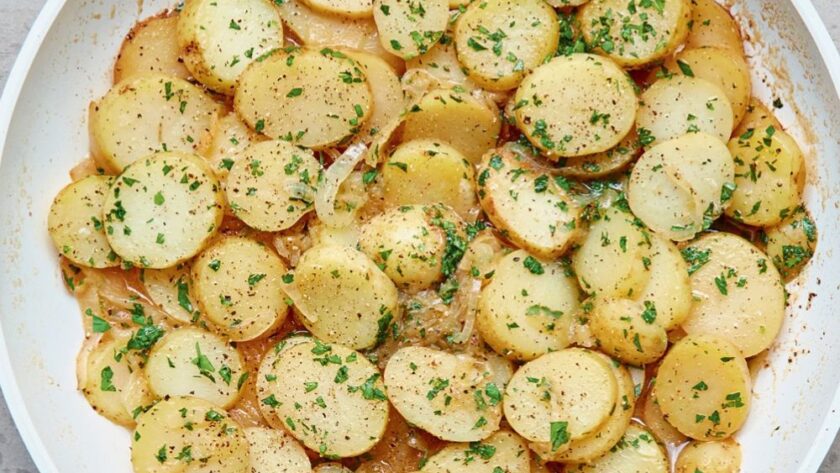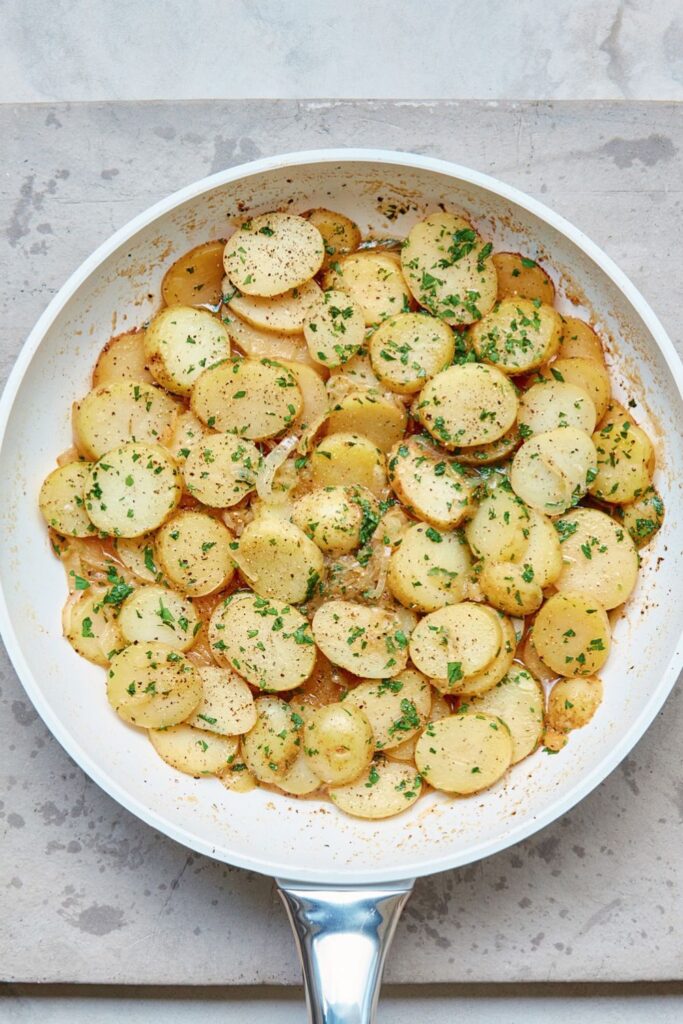I made these on a weeknight when I was done with oven trays and washing up—just wanted something warm and comforting that didn’t require five pots. I’d scribbled this recipe down ages ago from Mary Berry’s Quick Cooking, and to be honest, I didn’t expect much. I thought: sliced potatoes in a pan? Surely they’ll just go mushy or stick.
Reader, the first time I cooked this, I scorched the onions and forgot the lemon juice. Still edible, but a bit… beige. The second time? Magic. Silky, savoury potatoes soaked in buttery stock with a hint of citrus and just the right bit of bite.
It’s now my secret weapon side dish—and I’ll show you exactly how I stopped the spuds from turning to glue.
Why This One Works So Well
Most recipes for sautéed or skillet potatoes either go too fast and burn the outsides, or drown everything in butter without seasoning. What makes this one shine is balance—slow steaming first, then reducing the stock so the flavours cling to every slice.
The lemon juice at the end? Total game changer. It lifts the whole dish without making it feel “lemony”—just bright and moreish.
Also: don’t skip the lid. It’s not a garnish. It’s what keeps everything tender and steamy without frying to death.
INGREDIENTS + WHY THEY MATTER
- Sunflower oil – Has a high smoke point, so you get the buttery flavour without burning it. I tried with olive oil once—bad idea. Bitter and heavy.
- Butter (25g) – For flavour and richness. I used salted, then held back on extra salt at the end.
- 1 onion, finely sliced – Adds sweetness and depth. Key is slicing thin so it melts into the dish.
- 500g baby new potatoes – Keep the skins on! They add texture and stop it from going mushy. Sliced to ½ cm is not optional—chunky potatoes just don’t soak up the stock properly.
- 200ml vegetable or chicken stock – I used homemade chicken stock one day and cube-based the next—both worked, but homemade gives a deeper savoury base.
- 1 tbsp lemon juice – Brightens and cuts through the richness. I forgot it once—it tasted flat.
- 2 tbsp chopped parsley – It’s not just for looks. Adds freshness that balances the buttery base.
Making It Yours (Without Ruining It)
- No onions? Try shallots for a softer flavour—but don’t skip alliums entirely.
- Dairy-free? I tested with a plant butter (Flora) and it still worked—slightly less depth, but fine.
- Vegan? Use vegetable stock + dairy-free butter as above.
- Herb swaps: Thyme or chives are great—don’t go overboard or it overpowers.
- Want crispy edges? Finish under the grill for 3–4 minutes uncovered. But keep an eye—burns quick!
MISTAKES I’VE MADE (AND HOW TO AVOID THEM)
| What Went Wrong | Why It Happens | How to Fix It |
|---|---|---|
| Potatoes stuck to the pan | Too high heat at the start | Start on medium, stir gently, and don’t skip the oil |
| Soggy texture | Sliced too thick | Use a mandoline or sharp knife—1cm max |
| Flat taste | Forgot lemon juice | Always finish with acid—it lifts everything |
| Burnt onions | Pan too hot when adding them | Let butter foam, then turn heat to medium |
HOW TO MAKE MARY BERRY’S FRENCH BUTTERED POTATOES
- Heat oil and butter in a large non-stick frying pan over high heat until the butter foams.
- Add onions and potatoes. Stir gently so everything’s slicked with buttery oil.
- Cover and reduce heat to medium. Let it steam for 10 minutes—don’t peek!
- Pour in the stock, cover again, and cook another 10 minutes. Potatoes should be tender when poked.
- Uncover and turn up heat slightly to let some liquid reduce—about 5 more minutes. You’ll see a glaze forming.
- Season well, then stir in lemon juice and parsley gently.
- Serve warm—ideally straight from the pan into a shallow bowl.

TIPS FROM MY KITCHEN
- I cut the potatoes with a mandoline—quicker and more even cooking.
- I sometimes add half a garlic clove, smashed, in with the onions for an extra hum.
- If my parsley’s looking sad, I’ll swap it for a tiny bit of fresh thyme instead.
- My frying pan is ancient and thin-bottomed—so I use a heat diffuser to stop the bottom catching.
STORAGE + SERVING
- Fridge: Up to 3 days, tightly covered.
- Freeze: Yes—freeze flat in a zip bag, reheat gently in a pan with a splash of water or butter.
- Reheat: Oven at 180°C covered with foil (10 mins), or in a pan on low.
- Serve with: Grilled pork, baked fish, green beans, or just a fried egg on top. Honestly, it steals the show even beside a roast.
FAQs – Real Query Answers
Q: Can I slice the potatoes ahead of time?
A: Yes—but keep them in cold water so they don’t go grey. Pat dry before cooking or they’ll steam, not sauté.
Q: Can I use large potatoes instead of baby ones?
A: You can, but they must be waxy (like Charlotte or Yukon Gold). Floury ones fall apart.
Q: What’s the best pan to use?
A: A wide, heavy-bottomed sauté pan with a lid. Non-stick helps avoid sticking when the liquid reduces.
Q: Is this like French pommes boulangère?
A: Similar vibe—but that’s oven-baked. This is faster, stovetop, and a bit silkier.
Try More Recipes:
- Mary Berry Garlic Herb Flatbreads Recipe
- Mary Berry Brussel Sprouts With Peas and Cashews
- Mary Berry Carrot and Beetroot Slaw
- Mary Berry Tiger Prawn Courgetti
Mary Berry French Buttered Potatoes
Course: Side DishesCuisine: BritishDifficulty: Easy4
servings10
minutes20
minutes200
kcalSilky, buttery pan-cooked potatoes with onion, lemon, and parsley—an easy side dish that’s full of flavour.
Ingredients
2 tbsp sunflower oil
25g (1oz) butter
1 onion, finely sliced
500g (1lb 2oz) baby new potatoes, sliced no thicker than 1cm
200ml (7fl oz) veg or chicken stock
1 tbsp lemon juice
2 tbsp chopped parsley
Salt and black pepper to taste
Directions
- Heat oil and butter in a large frying pan until butter foams.
- Add onion and potatoes, stir to coat.
- Cover and cook over medium heat for 10 minutes.
- Pour in stock, cover again, cook another 10 minutes until tender.
- Remove lid, raise heat slightly to reduce liquid (about 5 mins).
- Season, stir in lemon juice and parsley gently.
- Serve warm.
Notes
- I cut the potatoes with a mandoline—quicker and more even cooking.
- I sometimes add half a garlic clove, smashed, in with the onions for an extra hum.
- If my parsley’s looking sad, I’ll swap it for a tiny bit of fresh thyme instead.
- My frying pan is ancient and thin-bottomed—so I use a heat diffuser to stop the bottom catching.

